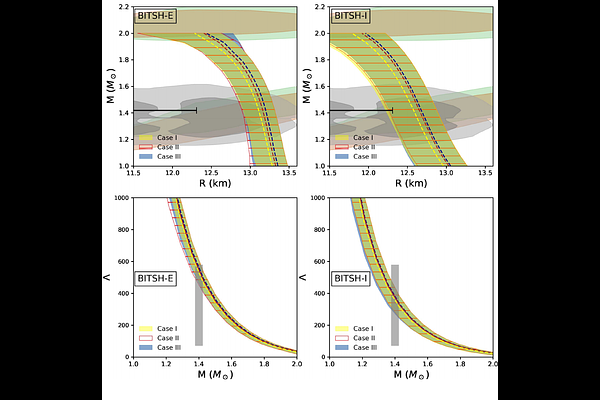Exploring Fermionic Dark Matter Admixed Neutron Stars in the Light of Astrophysical Observations

Exploring Fermionic Dark Matter Admixed Neutron Stars in the Light of Astrophysical Observations
Payaswinee Arvikar Dharampeth M. P. Deo Memorial Science College, Nagpur, India Department of Physics, BITS-Pilani Hyderabad Campus, Hyderabad, India, Sakshi Gautam Department of Physics, BITS-Pilani Hyderabad Campus, Hyderabad, India Department of Physics, Panjab University, Chandigarh, India, Anagh Venneti Department of Physics, BITS-Pilani Hyderabad Campus, Hyderabad, India, Sarmistha Banik Department of Physics, BITS-Pilani Hyderabad Campus, Hyderabad, India
AbstractWe studied the properties of dark matter admixed-neutron stars (DMANS), considering fermionic dark matter (DM) that interacts gravitationally with hadronic matter (HM). Using relativistic mean-field equations of state (EoSs) for both components, we solved the two-fluid Tolman Oppenheimer Volkoff (TOV) equations to determine neutron star (NS) properties assuming that DM is confined within the stellar core. For hadronic matter, we employed realistic EoSs derived from low energy nuclear physics experiments, heavy-ion collision data, and NS observations. To constrain key dark matter parameters such as particle mass, mass fraction, and the coupling to mass ratio, we applied Bayesian inference, incorporating various astrophysical data including mass, radii, and NICER mass-radius distributions for PSR J0740+6620 and PSR J0030+0451. Additionally, we explored the influence of high-density HM EoSs and examined the impact of stiffer hadronic EoSs, excluding the vector meson self-interaction term. Our findings indicate that current astrophysical observations primarily constrain the dark matter fraction, while providing limited constraints on the particle mass or coupling. However, the dark matter fraction is largely insensitive to how astrophysical observations or uncertainties in the high-density EoS are incorporated. Instead, it is predominantly determined by the stiffness of the hadronic EoS at high densities, with stiffer hadronic EoSs yielding a higher dark matter mass fraction. Therefore, we conclude that the dark matter fraction plays a crucial role in shaping the properties of DMANS. Future investigations incorporating more realistic EoSs and astrophysical observations of other compact objects may provide deeper insights into dark matter.